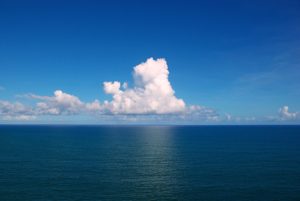Weather is very unpredictable, to say the least. Every evening captain Dan downloads weather forecasts, computer generated ones, which he then studies intensely before telling me what the predictions are for the next few days. Predictions, really? At best a guessing game as far as I’m concerned. After we left New Zealand we waited for ten days for predicted westerlies. And every evening Dan was convinced they’d arrive 6:00am the next morning because the computer said so. It never happened. I got many examples of predictions that never came true, but sometimes they do. Have to. The odds of a guessing game.
Nevertheless, there are weather patterns that govern the oceans and are very similar from year to year due to the rotation of the earth. At the bottom of the southern hemisphere we find mostly winds coming from the southeast. Above that, there is a banner with winds mostly coming from the northwest. Then a high-pressure zone followed by the trade winds coming from the southeast. At the middle of the earth we have a banner called the Intertropical conversion zone, better known as the doldrums, which includes the equator. It extends north and south of the equator and is a low-pressure zone. North of that area are the trade winds in the northern hemisphere coming from the northeast. Then a high-pressure zone followed by a zone of prevailing westerlies and then north easterlies at the top of the world.
Obviously, that is a very rough sketch of the winds around the world. Just a list of the most general zones, probably a million patterns within them. Plus the boundaries are very fluid. At one point the conversion zone can be fifty miles wide at another point three hundred and fifty, or anything in between.
So when we left Tahiti going due north we knew we were going to hit these zones, or at least some of them. We had enough diesel with us to motor through the doldrums. After that we just needed wind and more wind to get to Hawaii. We made very slow progress coming out of Tahiti and then one day it just stopped. Nada, no progress at all. Welcome to the intertropical conversion zone. Welcome to the doldrums.
The book ‘The American Practical Navigator’, better known as ‘Bowditch’ after it’s original author, Nathaniel Bowditch, is generally thought of as the accepted authority on piloting and other forms of navigation and other nautical matters. The book says that the doldrums, or the equatorial calm, is a belt of low pressure at the earth’s surface near the equator. Hot sultry days, overcast, showers and thunderstorms.
This is where people went berserk in the olden days sailing tall ships around the world. For weeks, sometimes months, they would lye there in the blistering sun, often short of water, eating foul food, waiting for a bit of a breeze. Morale would get to its lowest point and often harsh disciplinary actions were dished out to deal with fist and knife fights or even murder. Because of this type of history, Dan and I had agreed right at the beginning of this trip that we would not let it come to that. Whatever the weather was going to be, we were not to pull a knife on each other. And so far we have stuck to it.
But get this, according to Bowditch, along the poleward side of each trade wind belt is another region with light variable winds. These are called the horse latitudes. Horse latitudes? Yes! Apparently so named because becalmed sailing ships threw horses overboard in this region. Say what? Has to be one of those ‘other nautical matters’ that Bowditch is the authority on.
About five years ago, almost to the day, three of us had sailed to a small Alaskan island, Beautiful little place, but can’t remember its name if my life depended on it, I’d kept a journal, but unfortunately left that behind in a Starbucks somewhere in Seattle. One lane with small houses mostly on the waterfront. Very few residents year around, mostly houses owned by people from Juneau that took their boats across for visits. We had walked the island. Way more dogs than people. There even was a doggy graveyard. And slugs. Slugs everywhere. Big green slugs.
There even was a library slash community center slash something else. We didn’t count on it, but thought with a little luck we might get internet access here. We didn’t, but tremendously friendly people in the library and we stayed for a while talking about life on the island and how it was for a full-time resident. Other people joined us and the two locals reminisced about the recent Fourth of July celebrations, only a few days ago. Who was here, who did what and who turned out to be the winner of the annual slug throwing contest. I beg your pardon! Seriously, slug throwing? Who does that? Something about clearing the roof and then measure who throws the farthest. I was told everybody does it. Obviously PETA hasn’t made many inroads here yet.
So reading about the horse throwing reminded me of the slug throwing and then I turned that around into a horse throwing competition. In my mind I see these big burly bearded guys lining up on the ships, each with a horse in their arms and let the best man win. See how far you can throw that ungulate. And overboard they went. That’s how we celebrate the fourth of July on a ship you fools. Slugs, who need them? Of course, it wasn’t like that. Reading on in Bowditch, we see that they threw horses overboard when water supplies ran short. But I question that. I seriously question Bowditch’s authority on ‘other nautical matters’ here. Wouldn’t they just eat the horses?
For more than two days we motored. We don’t like using the motor, It’s noisy, it’s polluting, but we don’t like knives in our backs either and there was zero wind. The way the winds died at the south side of the equator is the way they came back with a vengeance on the north side. We were in the northern hemisphere now. All of a sudden those north easterlies were upon us. Out of the zone into the trades. We unfurled the genoa, put a reef in the main and pointed the bow towards Honolulu. We’ll be there for the fourth of July if all goes well. Wonder what throwing competition we might get into there.


